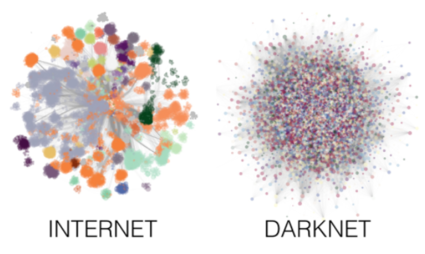Stuff The Internet Says On Scalability For April 7th, 2017
Hey, it's HighScalability time:

- 10-20: aminoacids can be made per second; 64800x: faster DDL Aurora vs MySQL; 25 TFLOPS: cap for F1 simulations; 15x to 30x: Tensor Processing Unit faster than GPUs and CPUs; 100 Million: Intel transistors per square millimeter; 25%: Internet traffic generated by Google; $1 million: Tim Berners-Lee wins Turing Award; 43%: phones FBI couldn't open because of crypto;
- Quotable Quotes:
- @adulau: To summarize the discussions of yesterday. All tor exit nodes are evil except the ones I operate.
- @sinavaziri: Let's say a data center costs $1-2B. Then the TPU saved Google $15-30B of capex?
- Vinton G. Cerf: While it would be a vast overstatement to ascribe all this innovation to genetic disposition, it seems to me inarguable that much of our profession was born in the fecund minds of emigrants coming to America and to the West over the past century.
- Alan Bundy: AI systems are not just narrowly focused by design, because we have yet to accomplish artificial Continue reading
Stuff The Internet Says On Scalability For March 31st, 2017
Hey, it's HighScalability time:

- 5000: node (150,000 pod) clusters in Kubernetes 1.6; 15 years: time to @spacex launch with a recycled rocket booster; 174 mbps: Internet speed in Dublin; 10 nm: Intel’s new Moore approved process; 30 minutes: to create Samsung's S8; 50 billion: of your cells replaced each day; 2 million: new red blood cells per second; 3dbm: attenuation of human body, same as a wall; 12: hours of tardis sounds; 350: pages to stop a bullet; 2: meters of DNA pack in a space .000006m wide;
- Quotable Quotes:
- @swardley: Having met many "leaders" in technology & business, I wouldn't bet on the future survival of humanity. If anything AI might help the odds
- Francis Pouliot: Any contentious hard fork of the Bitcoin blockchain shall be considered an alternative cryptocurrency (altcoin), regardless of the relative hashing power on the forked chain.
- @coda: WhatsApp: 900M users, built w/ < 35 devs, using #erlang Krispy Kreme: 1004 locations, 3700 employees, original glazed is 190 #calories
- @BenedictEvans: Still think Continue reading
How to speed up your MySQL with replication to in-memory database
Original article available at https://habrahabr.ru/company/mailru/blog/323870/
I’d like to share with you an article based on my talk at Tarantool Meetup(the video is in Russian, though). It’s a short story of why Mamba, one of the biggest dating websites in the world and the largest one in Russia, started using Tarantool. Why did we decide to busy ourselves with MySQL-to-Tarantool replication?
First, we had to migrate to MySQL 5.7 at some point, but this version didn’t have HandlerSocket that was being actively used on our MySQL 5.6 servers. We even contacted the Percona team — and they confirmed MySQL 5.6 is the last version to have HandlerSocket.
Second, we gave Tarantool a try and were pleased with its performance. We compared it against Memcached as a key-value store and saw the speed double from 0.6 ms to 0.3 ms on the same hardware. In relative terms, Tarantool’s twice as fast as Memcached. In absolute terms, it’s not that cool, but still impressive.
Third, we wanted to keep the whole existing architecture. There’s a MySQL master server and its slaves — we didn’t want to change anything in this structure. Can MySQL 5.6 slaves with HandlerSocket be replaced Continue reading
Sponsored Post: ButterCMS, Aerospike, Loupe, Clubhouse, Stream, Scalyr, VividCortex, MemSQL, InMemory.Net, Zohocorp

Who's Hiring?
- Advertise your job here!
Fun and Informative Events
- Analyst Webinar: Forrester Study on Hybrid Memory NoSQL Architecture for Mission-Critical, Real-Time Systems of Engagement. Thursday, March 30, 2017 | 11 AM PT / 2 PM ET. In today’s digital economy, enterprises struggle to cost-effectively deploy customer-facing, edge-based applications with predictable performance, high uptime and reliability. A new, hybrid memory architecture (HMA) has emerged to address this challenge, providing real-time transactional analytics for applications that require speed, scale and a low total cost of ownership (TCO). Forrester recently surveyed IT decision makers to learn about the challenges they face in managing Systems of Engagement (SoE) with traditional database architectures and their adoption of an HMA. Join us as our guest speaker, Forrester Principal Analyst Noel Yuhanna, and Aerospike’s VP Marketing, Cuneyt Buyukbezci, discuss the survey results and implications for your business. Learn and register.
- Advertise your event here!
Cool Products and Services
- InMemory.Net provides a Dot Net native in memory database for analysing large amounts of data. It runs natively on .Net, and provides a native .Net, COM & ODBC apis for integration. It also has an easy to use language for importing data, and supports Continue reading
Faster Networks + Cheaper Messages => Microservices => Functions => Edge

When Adrian Cockroft—the guy who helped put the loud in Cloud through his energetic evangelism of Cloud Native and Microservice architectures—talks about what’s next, it pays to listen. And you can listen, here’s a fascinating forward looking talk he gave at microXchg 2017: Shrinking Microservices to Functions. It’s typically Cockroftian: understated, thoughtful, and full of insight drawn from experience.
Adrian makes a compelling case that the same technology drivers, faster networking and cheaper messaging, that drove the move to Microservices are now driving the move to Functions.
The payoffs are all those you’ve no doubt heard about Serverless for some time, but Adrian develops them in an interesting way. He traces how architectures have evolved over time. Take a look at my gloss of his talk for more details.
What’s next after Functions? Adrian talks about pushing Lambda functions to the edge. A topic I’m excited about and have been interested in for sometime, though I didn’t quite see it playing out like this.
Datacenters disappear. Functions are not running in an AWS region anymore, code is placed near the customer using a CDN at CDN endpoints. Now you have a fully distributed, at the edge, low Continue reading
Stuff The Internet Says On Scalability For March 24th, 2017
Hey, it's HighScalability time:
- 40Gbit/s: indoor optical wireless networks; 15%: energy produced by wind in Europe; 5: new tasty particles; 2000: Qubits are easy; 30 minutes: flight time for electric helicopter; 42.9%: of heathen StackOverflowers prefer tabs;
- Quotable Quotes:
- @RichRogersIoT: "Did you know? The collective noun for a group of programmers is a merge-conflict." - @omervk
- @tjholowaychuk: reviewed my dad's company AWS expenses, devs love over-provisioning, by like 90% too, guess that's where "serverless" cost savings come in
- @karpathy: Nature is evolving ~7 billion ~10 PetaFLOP NI agents in parallel, and has been for ~10M+s of years, in a very realistic simulator. Not fair.
- @rbranson: This is funny, but legit. Production software tends to be ugly because production is ugly. The ugliness outpaces our ability to abstract it.
- @joeweinman: @harrietgreen1 : Watson IoT center opened in Munich... $200 million dollar investment; 1000 engineers #ibminterconnect
- David Gerard: This [IBM Blockchain Service] is bollocks all the way down.
- digi_owl Continue reading
Stuff The Internet Says On Scalability For March 17th, 2017
Hey, it's HighScalability time:

- billion billion: exascale operations per second; 250ms: connection time saved by zero round trip time resumption; 800 Million: tons of prey eaten by spiders; 90%: accuracy of quantum computer recognizing trees; 80 GB/s: S3 across 2800 simultaneous functions;
- Quotable Quotes:
- @GossiTheDog: Here's something to add to your security threat model: backups. Why steal live data and when you can drive away with exact replica?
- @ThePublicSquare: "California produces 160% of its 1990 manufacturing, but with just 60% of the workers." -@uclaanderson economist Jerry Nickelsburg
- @rbranson: makes total sense. I have a friend (who is VC-backed) that has stuff in Azure, GCloud, and AWS to maximize the free credits.
- @AndrewYNg: If not for US govt funding (DARPA, NSF), US wouldn't be an AI leader today. Proposed cuts to science is big step in wrong direction.
- @CodeWisdom: "To understand a program you must become both the machine and the program." - Alan Perlis
- @codemanship: What does it take Continue reading
Architecture of Probot – My Slack and Messenger Bot for Answering Questions

I programmed a thing. It’s called Probot. Probot is a quick and easy way to get high quality answers to your accounting and tax questions. Probot will find a real live expert to answer your question and handle all the details. You can get your questions answered over Facebook Messenger, Slack, or the web. Answers start at $10. That’s the pitch.
Seems like a natural in this new age of bots, doesn’t it? I thought so anyway. Not so much (so far), but more on that later.
I think Probot is interesting enough to cover because it’s a good example of how one programmer--me---can accomplish quite a lot using today’s infrastructure.
All this newfangled cloud/serverless/services stuff does in fact work. I was able to program a system spanning Messenger, Slack, and the web, in a way that is relatively scalabile, available, and affordable, while requiring minimal devops.
Gone are the days of worrying about VPS limits, driving down to a colo site to check on a sick server, or even worrying about auto-scaling clusters of containers/VMs. At least for many use cases.
Many years of programming experience and writing this blog is no protection against making mistakes. I made a Continue reading
Sponsored Post: Aerospike, Loupe, Clubhouse, GoCardless, Auth0, InnoGames, Contentful, Stream, Scalyr, VividCortex, MemSQL, InMemory.Net

Who's Hiring?
- GoCardless is building the payments network for the internet. We’re looking for DevOps Engineers to help scale our infrastructure so that the thousands of businesses using our service across Europe can take payments. You will be part of a small team that sets the direction of the GoCardless core stack. You will think through all the moving pieces and issues that can arise, and collaborate with every other team to drive engineering efforts in the company. Please apply here.
- InnoGames is looking for Site Reliability Engineers. Do you not only want to play games, but help building them? Join InnoGames in Hamburg, one of the worldwide leading developers and publishers of online games. You are the kind of person who leaves systems in a better state than they were before. You want to hack on our internal tools based on django/python, as well as improving the stability of our 5000+ Debian VMs. Orchestration with Puppet is your passion and you would rather automate stuff than touch it twice. Relational Database Management Systems aren't a black hole for you? Then apply here!
- Contentful is looking for a JavaScript BackEnd Engineer to join our team in their mission of Continue reading
Stuff The Internet Says On Scalability For March 10th, 2017
Hey, it's HighScalability time:

- > 5 9s: Spanner availability; 200MB: random access from DNA storage; 215 Pbytes/gram: DNA storage; 287,024: Google commits to open source; 42: hours of audio gold; 33: minutes to get back into programming after interruption; 12K: Chinese startups started per day; 35 million: tons of good shipped under Golden Gate Bridge; 209: mph all-electric Corvette; 500: Disney projects in the cloud; 40%: rise in CO2;
- Quoteable Quotes:
- Marc Rogers: Anything man can make man can break
- @manupaisable: 10% of machines @spotify rebooted every hour because of defunct #docker - war stories by @i_maravic @qconlondon
- @robertcottrell: “the energy cost of each bitcoin transaction is enough to power 3.17 US households for a day”
- Eric Schmidt: We put $30 billion into this platform. I know this because I approved it. Why replicate that?
- dim: It uses p30 technology. Just basic things, gliders and lightweight spaceships. Basically, the design goes top-down: At the very top, there's the Continue reading
Part 4 of Thinking Serverless — Addressing Security Issues
This is a guest repost by Ken Fromm, a 3x tech co-founder — Vivid Studios, Loomia, and Iron.io. Here's Part 1 and 2 and 3.
This post is the last of a four-part series of that will dive into developing applications in a serverless way. These insights are derived from several years working with hundreds of developers while they built and operated serverless applications and functions.
The platform was the serverless platform from Iron.io but these lessons can also apply to AWS Lambda, Google Cloud Functions, Azure Functions, and IBM’s OpenWhisk project.
Arriving at a good definition of cloud IT security is difficult especially in the context of highly scalable distributed systems like those found in serverless platforms. The purpose of this post is to not to provide an exhaustive set of principles but instead highlight areas that developers, architects, and security officers might wish to consider when evaluating or setting up serverless platforms.
Serverless Processing — Similar But Different
High-scale task processing is certainly not a new concept in IT as it has parallels that date back to the days of job processing on mainframes. The abstraction layer provided by serverless process — in combination with Continue reading
Stuff The Internet Says On Scalability For March 3rd, 2017
Hey, it's HighScalability time:

- $5 billion: Netflix spend on new content; $1 billion: Netflix spend on tech; 10%: bounced BBC users for every additional second page load; $3.5 billion: Priceline Group ad spend; 12.6 million: hours streamed by Pornhub per day; 1 billion: hours streamed by YouTube per day; 38,000 BC: auroch carving; 5%: decrease in US TV sets;
- Quotable Quotes:
- Fahim ul Haq: Rule 1: Reading High Scalability a night before your interview does not make you an expert in Distributed Systems.
- @Pinboard: Root cause of outage: S3 is actually hosted on Google Cloud Storage, and today Google Cloud Storage migrated to AWS
- Matthew Green: ransomware currently is using only a tiny fraction of the capabilities available to it. Secure execution technologies in particular represent a giant footgun just waiting to go off if manufacturers get things only a little bit wrong.
- dsr_: This [S3 outage] is analogous to "we needed to fsck, and nobody realized how long that would take".
- tptacek: Uber isn't the driver's employer. Continue reading
Getting Started with Lyft Envoy for Microservices Resilience

This is a guest repost by Flynn at datawireio on Envoy, a Layer 7 communications bus, used throughout Lyft's service-oriented architecture.
Using microservices to solve real-world problems always involves more than simply writing the code. You need to test your services. You need to figure out how to do continuous deployment. You need to work out clean, elegant, resilient ways for them to talk to each other.
A really interesting tool that can help with the “talk to each other” bit is Lyft’s Envoy: “an open source edge and service proxy, from the developers at Lyft.” (If you’re interested in more details about Envoy, Matt Klein gave a great talk at the 2017 Microservices Practitioner Summit.)
Envoy Overview
It might feel odd to see us call out something that identifies itself as a proxy – after all, there are a ton of proxies out there, and the 800-pound gorillas are NGINX and HAProxy, right? Here’s some of what’s interesting about Envoy:
- It can proxy any TCP protocol.
- It can do SSL. Either direction.
- It makes HTTP/2 a first class citizen, and can translate between HTTP/2 and HTTP/1.1 (either direction).
- It has good flexibility around discovery and Continue reading
Sponsored Post: Aerospike, Loupe, Clubhouse, GoCardless, Auth0, InnoGames, Contentful, Stream, Scalyr, VividCortex, MemSQL, InMemory.Net, Zohocorp

Who's Hiring?
- GoCardless is building the payments network for the internet. We’re looking for DevOps Engineers to help scale our infrastructure so that the thousands of businesses using our service across Europe can take payments. You will be part of a small team that sets the direction of the GoCardless core stack. You will think through all the moving pieces and issues that can arise, and collaborate with every other team to drive engineering efforts in the company. Please apply here.
- InnoGames is looking for Site Reliability Engineers. Do you not only want to play games, but help building them? Join InnoGames in Hamburg, one of the worldwide leading developers and publishers of online games. You are the kind of person who leaves systems in a better state than they were before. You want to hack on our internal tools based on django/python, as well as improving the stability of our 5000+ Debian VMs. Orchestration with Puppet is your passion and you would rather automate stuff than touch it twice. Relational Database Management Systems aren't a black hole for you? Then apply here!
- Contentful is looking for a JavaScript BackEnd Engineer to join our team in their mission of Continue reading
Business Case for Serverless

You can’t pick a technical direction without considering the business implications. Mat Ellis, Founder/CEO of Cloudability, in a recent CloudCast episode, makes the business case for Serverless. The argument goes something like:
-
Enterprises know they can’t run services cheaper than Amazon. Even if the cost is 2x the extra agility of the cloud is often worth the multiple.
-
So enterprises are moving to the cloud.
-
Moving to the cloud is a move to services. How do you build services now? Using Serverless.
-
With services businesses use a familiar cost per unit billing model, they can think of paying for services as a cost per database query, cost per terabyte of data, and so on.
-
Since employees are no longer managing boxes and infrastructure they can now focus entirely on business goals.
-
There’s now an opportunity to change business models. Serverless will make new businesses economically viable because they can do things they could never do before based on price and capabilities.
-
Serverless makes it faster to iterate and deploy new code which makes it faster to find a proper product/market fit.
-
Smaller teams with smaller budgets with smaller revenues can do things now that only big companies could do Continue reading
Stuff The Internet Says On Scalability For February 24th, 2017
Hey, it's HighScalability time:

- 40 TFLOPS: on Lambda; 7: new habitable planets with good beer; dozens: balloons needed in Loon network; 500 TB/sec: rate at which DNA is copied in human body; 1/2: web is encrypted; 34: regions in Azure; $8k: cost of Tesla self-driving hardware; 99.95%: DMCA takedowns are bot BS; 300 nanometers: new microscope; 7%: AMP traffic to publishers;
- Quotable Quotes:
- @jasonlk: Elon Musk: Self-Driving Car Revolution Will Leave 15% of World Population Without Jobs
- Near death Archimedes: Stand away, fellow, from my diagram!
- rumpelstilskin21: Angular and React make for popular headlines on reddit but unless you are working for a major, large web site where such things might be deemed useful by management (and no one else) then quit trying to get educated by the amateurs on reddit.
- StorageMojo: There is a new paradigm about to hit the industry, which will eviscerate large portions of Continue reading
Scaling @ HelloFresh: API Gateway
 HelloFresh keeps growing every single day: our product is always improving, new ideas are popping up from everywhere, our supply chain is being completely automated. All of this is simply amazing us, but of course this constant growth brings many technical challenges.
HelloFresh keeps growing every single day: our product is always improving, new ideas are popping up from everywhere, our supply chain is being completely automated. All of this is simply amazing us, but of course this constant growth brings many technical challenges.
Today I’d like to take you on a small journey that we went through to accomplish a big migration in our infrastructure that would allow us to move forward in a faster, more dynamic, and more secure way.
The Challenge
We’ve recently built an API Gateway, and now we had the complex challenge of moving our main (monolithic) API behind it — ideally without downtime. This would enable us to create more microservices and easily hook them into our infrastructure without much effort.
The Architecture
Stuff The Internet Says On Scalability For February 17th, 2017
Hey, it's HighScalability time:

- 1 cubic millimeter: computer with deep-Learning; 1,600: data on nearby stars; 40M: users for largest Parse app; 58x: Tensorflow 1.0 speedup on 64 gpus; 46%: ecommerce controlled by Amazon; 60%: IT growth in public cloud; 200 TB: one tv episode;
- Quotable Quotes:
- @krishnan: Serverless will not be around in 5 years. It will be AI coding AI coding Ai....... Serverless or not doesn't matter #RunForrestRun
- user5994461: Amazon: Create usual services and sell them. Google: Make unique products that push the boundaries of what was previously thought possible. Amazon: Don't care about inefficiencies and usage. Inefficiencies can be handled by charging more to the clients, usage doesn't matter because the users are mostly the clients and they don't feel their pain. Google: Had to make all their core technologies efficient, performant, scalable and maintainable or they couldn't sustain their business.
- Hans Rosling: To me, the impressive thing is that people succeed at all.
- @littleidea: Google Spanner didn't beat CAP, just mitigated the hell Continue reading
Sponsored Post: Aerospike, GoCardless, Auth0, InnoGames, Contentful, Stream, Scalyr, VividCortex, MemSQL, InMemory.Net, Zohocorp

Who's Hiring?
- GoCardless is building the payments network for the internet. We’re looking for DevOps Engineers to help scale our infrastructure so that the thousands of businesses using our service across Europe can take payments. You will be part of a small team that sets the direction of the GoCardless core stack. You will think through all the moving pieces and issues that can arise, and collaborate with every other team to drive engineering efforts in the company. Please apply here.
- InnoGames is looking for Site Reliability Engineers. Do you not only want to play games, but help building them? Join InnoGames in Hamburg, one of the worldwide leading developers and publishers of online games. You are the kind of person who leaves systems in a better state than they were before. You want to hack on our internal tools based on django/python, as well as improving the stability of our 5000+ Debian VMs. Orchestration with Puppet is your passion and you would rather automate stuff than touch it twice. Relational Database Management Systems aren't a black hole for you? Then apply here!
- Contentful is looking for a JavaScript BackEnd Engineer to join our team in their mission of Continue reading
Part 3 of Thinking Serverless — Dealing with Data and Workflow Issues
This is a guest repost by Ken Fromm, a 3x tech co-founder — Vivid Studios, Loomia, and Iron.io. Here's Part 1 and 2.
This post is the third of a four-part series of that will dive into developing applications in a serverless way. These insights are derived from several years working with hundreds of developers while they built and operated serverless applications and functions.
The platform was the serverless platform from Iron.io but these lessons can also apply to AWS Lambda, Google Cloud Functions, Azure Functions, and IBM’s OpenWhisk project.
Serverless Processing — Data Diagram